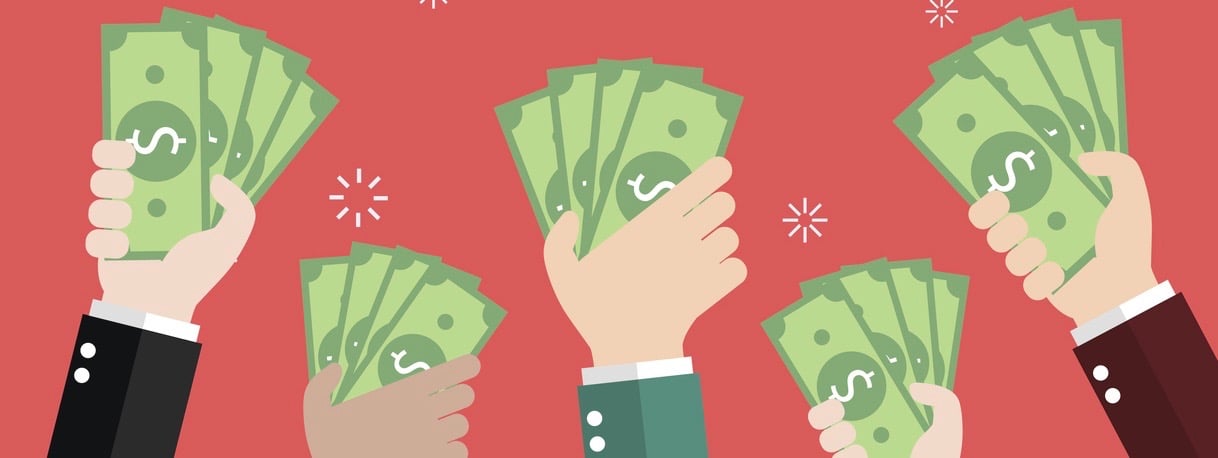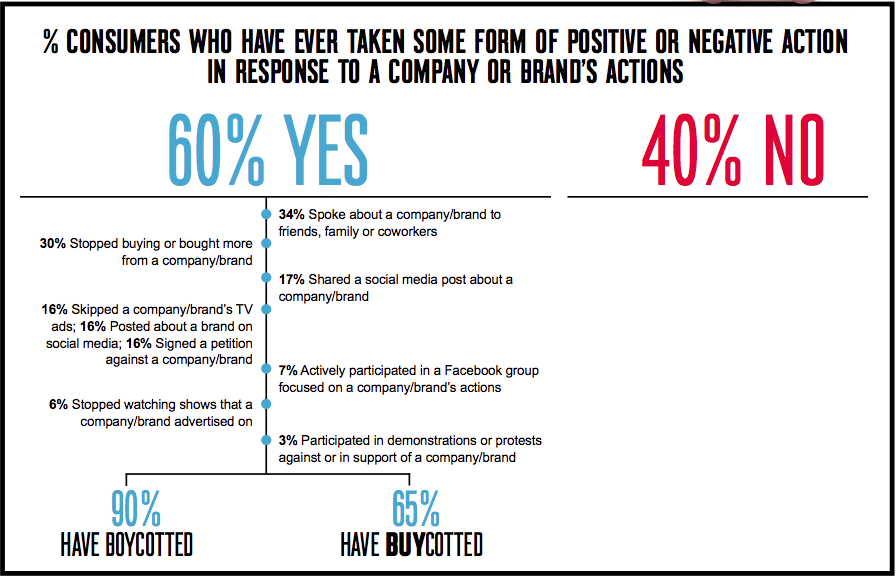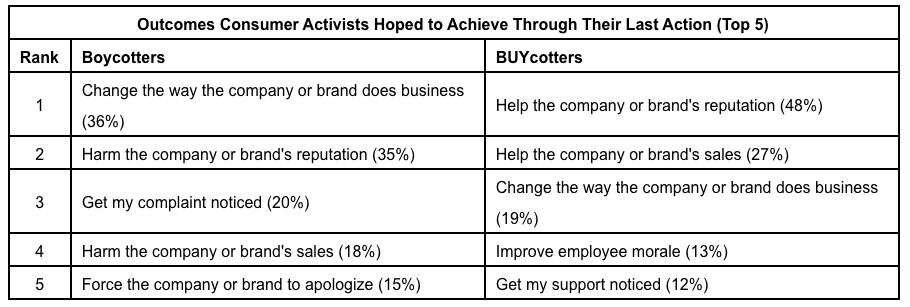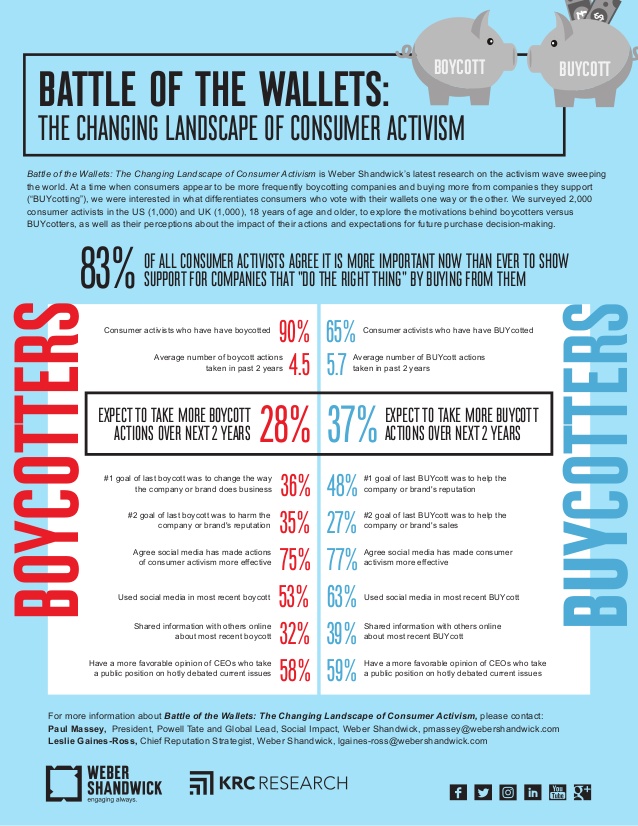New research from Weber Shandwick, in partnership with KRC Research, reveals a transformation in consumer activism and advocacy as buyers increasingly vote with their wallets to show support for companies and brands.
The firms’ new study finds that 83 percent of consumer activists in the U.S. and UK agree it is more important than ever to show support for companies that do the right thing by buying from them. This form of purchasing behavior, known as BUYcotting, occurs when consumers show support for a company’s actions by intentionally buying its brands, products or services, while fewer consumer activists (59 percent) say it is more important than ever to participate in boycotts.
In fact, BUYcotters have taken more supportive purchase actions on average in the past two years than boycotters have taken in opposition (5.7 vs. 4.5, respectively), according to the study, Battle of the Wallets: The Changing Landscape of Consumer Activism, conducted as a survey among 2,000 consumer activists—company brand or product boycotters and supporters—ages 18 and older in the U.S. and UK. Respondents were classified as boycotters or BUYcotters based on whether they have ever boycotted or supported a company through purchase decisions.
Reputation-building driving force behind BUYcotters’ purchase decisions
By far, the primary motivation for BUYcott behavior is to support a company or brand’s reputation, cited by nearly half of BUYcotters (48 percent). For boycotters, changing the way a company or brand does business is the top motivator (36 percent), but that is nearly tied with harming the reputation of the boycott target (35 percent). In both boycott and BUYcott cases, impacting sales takes a back seat to impacting reputation.
“The influence that consumer activism has on company reputation should not be overlooked,” said Leslie Gaines-Ross, chief reputation strategist at Weber Shandwick, in a news release. “While many companies may be concerned about the financial impact of a boycott, the effect on reputation is often the consumer activist’s priority. Companies should consider this ramification when faced with a boycott, and, alternatively, look for opportunities to leverage the power of BUYcotters who are willing to support and positively influence a brand’s reputation.”
BUYcott movement expected to outpace boycotts
BUYcotts are expected to grow at a faster pace than boycotts over the next few years for several reasons identified by the research:
- BUYcotters expect to take more action in the future: Nearly four in 10 BUYcotters (37 percent) expect to take more action over the next two years, a rate significantly higher than that of boycotters who expect to take more action (28 percent).
- BUYcotters skew younger: BUYcotters have a median age of 43 compared to 46 for boycotters. Four in 10 BUYcotters (41 percent) are members of the youngest generations, Millennials and Gen Z, versus 33 percent of boycotters. Boomers and older make up a larger share of the boycott segment (40 percent vs. 30 percent of BUYcotters). If this generational pattern continues, BUYcotters will surpass boycotters as Millennials and Gen Zers grow to be a larger segment of the shopper population.
- There is a lack of confidence in boycotts: One in four boycotters (26 percent) do not think they can personally change anything by boycotting.
“We are at an inflection point in consumer activism today. Companies operate on an increasingly public stage, with mainstream media and social platforms accelerating consumer movements like never before,” said Paul Massey, president of Powell Tate and global lead of Social Impact at Weber Shandwick, in the release. “In some cases, boycotts and counter BUYcotts emerge almost simultaneously, with emotions running high on both sides. But we may be seeing a reaction to this divisiveness, with BUYcotts gaining in stature as consumers increasingly seek alternative ways to make their voices heard.”
Social media plays greater role in BUYcotts
Boycotters and BUYcotters both agree that social media makes the actions of boycotts and support more effective (75 percent of boycotters and 77 percent of BUYcotters). However, BUYcotters are more likely than boycotters to have used a social media platform (e.g., Facebook, Twitter, WhatsApp or Instagram) in their most recent activist action (63 percent vs. 53 percent). BUYcotters are also more likely than boycotters to have shared information with others online about their most recent action (39 percent vs. 32 percent, respectively) and to say social media and online research informed their most recent action (23 percent vs. 17 percent, respectively).
Social media having a greater role for BUYcotters is not a result of BUYcotters skewing younger in age. Older generation BUYcotters are more likely than their peer group boycotters to have used social media in their most recent action.
Regional differences
The research found several differences between US and UK consumer activists:
- Supporting companies through BUYcotts is more prevalent in the U.S. (72 percent) than the UK (58 percent): However, U.S. and UK BUYcotters have BUYcotted about the same number of times on average over the past two years (5.2 and 5.0 actions, respectively).
- Expectations for future consumer activism are stronger among U.S. consumers: Forty-five percent of U.S. BUYcotters expect to take more support actions in the next two years compared to 29 percent of UK consumers. Similarly, 34 percent of U.S. boycotters expect to boycott more over the next two years compared to 22 percent of UK boycotters. This is not to say that consumer activism is on the decline in the UK, as half of UK BUYcotters (52 percent) and boycotters (52 percent) expect to take the same number of actions over the past two years.
Guidelines for managing consumer activism
Based on the research findings, Weber Shandwick recommends the following strategies to companies to navigate consumer activism and the growth of the BUYcott movement:
- Consider that consumer activism, both positive and negative, shapes reputation
- Anticipate potential boycotts and expect more BUYcotting behavior; plan strategically for each
- Activate a cross-functional task force to manage planning and execution of any potential response
- Cultivate the BUYcotter community and leverage the powerful opportunity to embrace customers as willing and active brand advocates
- Identify and get to know formal and informal consumer activist groups
- Listen before acting, on social media or otherwise
- Use search engine optimization to its fullest to disseminate information and rally support
Weber Shandwick, in partnership with KRC Research, conducted an online survey of 2,000 company, brand or product boycotters or supporters in the U.S. (1,000) and U.K. (1,000). Respondents were adults 18 years and older, demographically matched to represent their respective national populations, to find out why, and the extent to which, they boycott or support certain products or brands. Interviews were conducted in August 2017.












